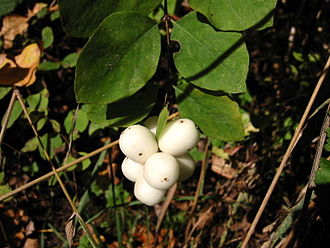Symphoricarpos

Symphoricarpos, commonly known as the snowberry, waxberry, or ghostberry, is a small genus of about 15 species of deciduous shrubs in the honeysuckle family, Caprifoliaceae. With the exception of the Chinese coralberry, S. sinensis, which is indigenous to western China, all species are native to North and Central America. The name of the genus is derived from the Ancient Greek words συμφορεῖν (sumphoreîn), meaning “to bear together”, and καρπός (karpós), meaning “fruit”. It refers to the closely packed clusters of berries the species produces.[4]
Snowberry is a resilient plant able to withstand a variety of conditions. Snowberry plants are most commonly found in forests, dry or moist openings, rocky hillsides or near riverbanks and streams.[5] They have been known to grow in a variety of soil types such as light sandy soil, medium loamy soil and heavier clay soil.[5] Snowberry plants are also able to grow in a wide range of acidic and basic pHs and sunlight conditions.[5]
Symphoricarpos leaves are 1.5–5 cm (0.59–1.97 in) long, rounded, entire or with one or two lobes at the base. The flowers are small, greenish-white to pink, in small clusters of 5–15 together in most species, solitary or in pairs in some (e.g. S. microphyllus). The fruit is conspicuous, 1–2 cm (0.5–1 in) in diameter, soft, varying from white (e.g. S. albus) to pink (S. microphyllus) to red (S. orbiculatus) and in one species (S. sinensis), blackish purple. When the white berries are broken open, the interior looks like fine, sparkling granular snow. The flesh is spongy and contains two 2–5 mm long, whitish stone seeds. The seeds, which contain endosperm and a small embryo, are egg-shaped and more or less flattened. They have a very tough, hard, impermeable covering, and so are very hard to germinate and may lie dormant for up to ten years.
The white berries create a cracking sound when they are stepped into firm ground.
